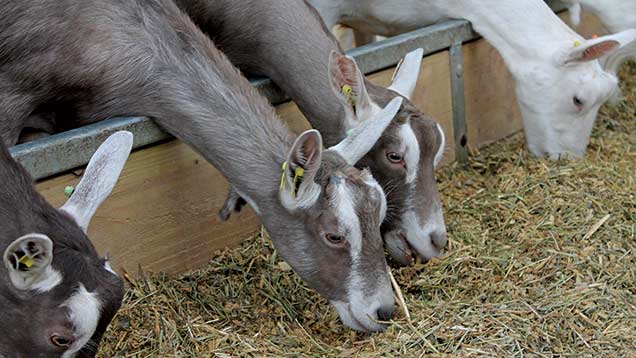How to make a profit from milk – with goats
 ©RBI (Rhian)
©RBI (Rhian) Recording milking data using EID, reformulating rations and improving feed regimes has helped Monmouthshire goat farmer Gary Yeomans increase milk yields by 21% in the past 12 months.
Last year the herd of 504 goats at Pant Farm, Abergavenny, Monmouthshire, was yielding 750 litres a goat/year on average.
But in the past year close attention to detail has seen yields boosted to 1,000 litres a goat/year, despite the fact the herd has expanded to 650 head.
Mr Yeomans and his wife Jess, who supply Abergavenny Fine Foods – the UK’s largest producer of fresh goats’ cheese, switched from milking cows to goats in 2002 in favour of the higher prices paid for goat milk.
The couple became part of a benchmarking group a few years ago and realised there was a big potential to boost yield by increasing the amount of concentrate fed.
Farm facts
- Own 49ha and rent a further 49ha
- 20/40 automatic swing-over parlour
- Feeding TMR
- Goats are housed all year round in loose straw sheds
- The herd is kidded down in three batches – autumn, spring and the goatlings kid in summer
- Regulin and lights are used to breed goats out of season. Lights are used to extend the day length in January and February. Regulin releases the hormone
- Billy goats are sold to another farmer to be reared for meat
- Rear their own replacements on ad-lib milk replacer and barley straw. Goats are given 16% crude protein creep at 10 days of age and are weaned off milk at 15kg – typically about eight weeks. Kept in pens of 15 on straw.
Nutrition
On the advice of independent nutritionist Tom Chamberlain, they increased concentrate use a goat by 13%.
Although feed costs have increased by 6p/goat/day (see table), margins have actually improved because the amount of milk produced/goat/day has gone from 2.7 litres to 3.2 litres.
Margin over feed has increased from 38.9p/litre up to April 2014 to 45.3p/litre up to April 2015, with only a 0.5p/litre milk price rise, explains Mr Yeomans.
Mr Yeomans feeds the milkers a total mixed ration (TMR) consisting of homegrown forages and cereals to make the most of farmland.
See also: Dairy farmer switches to milking goats
However, in the past year the energy density and fibre of the milking ration has been increased.
The two biggest changes in the ration were the increase in crude protein from 16.5% DM to 18% DM through the inclusion of soya bean meal and starch levels have improved from 24.7% DM to 30% DM by increasing maize in the diet, explains Mr Chamberlain.
Feed presentation
Better feed presentation has also helped boost dry matter intakes from 2.7kg DM/day to 3.2kg/DM/day.
Mr Yeomans installed a new feed barrier, which has improved access to the feed passage, and he is now pushing up feed three times a day.
“We clean out older feed once a day. We would like to put a polished floor in the shed next year to improve the feed surface,”explains Mr Yeomans.
He has also bought a new Keenan feed wagon that chops the ration with knives. He says this has improved chop length and mixes the ration much better.
Mr Chamberlain says each 500g increase in DMI equates to an extra litre of milk.
“Intakes are the key driver [of yield]. A goat eating 2.25% DM will only produce 2.5 litres of milk. If she eats 3.5% DM then she will produce 5.2 litres of milk. The more we can get them to eat the better,” explains Mr Chamberlain.
Recording
In January the Yeomans started milk recording monthly with an EID reader and this has helped them to selectively cull low yielders.
Mr Yeomans says since recording started they have culled hard, removing anything giving less than 2 litres/day. This has lowered numbers from 750 to 650, but they will be back up to 700 milking once kidding has finished.
“We did used to cull the low yielders but recording has given us a better handle on consistent low yielders.”
Mr Chamberlain says high output is a must for any goat business because the high biosecurity risks of keeping goats outdoors means it is difficult to graze goats.
“Most units are high input. It is very easy to become high input. The challenge is to become high output alongside it. Anything that is doing less than 1 litre/day is not covering your costs.”
Improvements in performance at Pant Farm
|
|
April 2014 |
April 2015 |
% Change |
|
Herd size |
504 |
650 |
21% |
|
Goats in milk |
475 |
570 |
20% |
|
Milk sold/year |
37,850 litres |
54,760 litres |
45% |
|
Milk/goat/day |
2.66 |
3.20 |
21% |
|
Fat |
4% |
4% |
– |
|
Protein |
3% |
3.1% |
– |
|
Concentrate used (T/m) |
15.58 |
21.56 |
38% |
|
Concentrate fed (kg) per goat/day |
1.03 |
1.17 |
13% |
|
Feed cost £/goat/day |
£0.32 |
£0.38 |
21% |
|
Concentrate fed kg/litre |
0.39 |
0.36 |
–6% |

